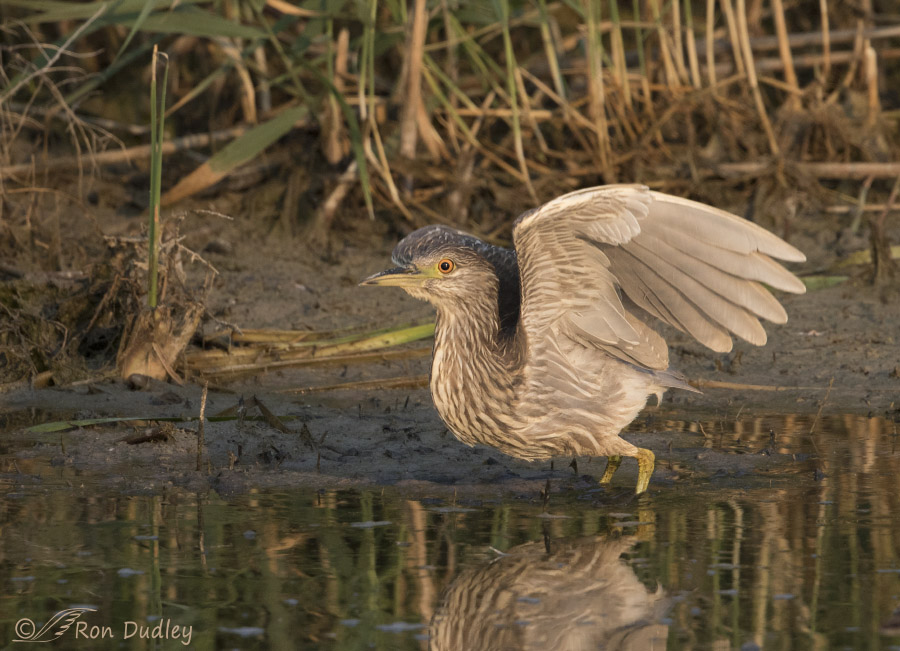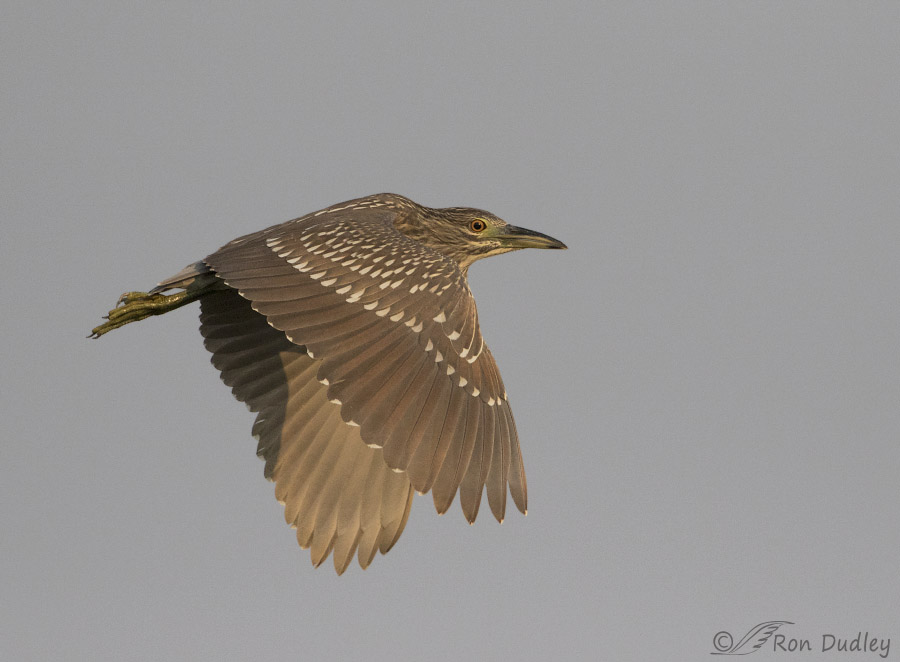These two images demonstrate how dramatically shutter speed can change in different lighting conditions when you’re shooting in aperture priority.

1/2500, f/6.3, ISO 1250, Canon 7D Mark II, Canon EF500mm f/4L IS II USM +1.4 tc, not baited, set up or called in
I photographed this juvenile Black-crowned Night Heron about two weeks ago at Bear River MBR. It was early in the morning and it was still somewhat smoky from the fires so the light is low and warm. I was anticipating take-off so I needed enough shutter speed to freeze the motion and had to go to ISO 1250 to get it. I think it worked out pretty well. I like the pose, the warm light on the bird, the natural setting and the action.
In a recent post there was a lot of discussion about using high ISO settings to get sufficient shutter speed and the digital noise that can result. At the request of a reader I plan on addressing that issue fairly soon but this post should demonstrate how quickly shutter speed can change in different conditions (when you’re shooting in aperture priority) and how much attention the photographer needs to pay to camera settings in the field whenever he/she has the time to do so.
Ok, back to this shot for a moment. Notice once again that the light on the setting, background and bird is low and filtered so I needed this high ISO to get sufficient shutter speed for take-off.

1/8000, f/6.3, ISO 1250, Canon 7D Mark II, Canon EF500mm f/4L IS II USM +1.4 tc, not baited, set up or called in
Just seconds later another juvenile heron flew by so I quickly raised my lens and fired off a few shots. I had no time to adjust my settings so it was one of those “spray and pray” situations. The exposure worked out pretty well (I increased exposure a little in processing) but check out that shutter speed. Since I was still shooting at ISO 1250 and the light was much brighter in the sky than it had been on the ground my shutter speed jumped all the way up to 1/8000 sec – much, much faster than I needed for the situation and as a result there’s noticeable noise in the background because of the high ISO. It isn’t bad (it would have been worse if the background had been darker or if I had cropped more tightly) but it’s more noticeable than it needed to be and it would be even more obvious in a large print.
Another geeky post I know but where would we be as photographers without a little geekiness in our lives…?
Ron


I really enjoyed the flight shot.
Hi Ron,
Have you ever experimented with “auto ISO”. I don’t know how you do it with Canon, but with Nikon you set your camera to manual, set the shutter speed and aperture, and the camera sets the ISO (within limits you set). I find I can adjust shutter speed and aperture with my eye to the camera much easier than changing ISO.
“Have you ever experimented with “auto ISO”.”
No, I haven’t, John. I like having control over ISO.
I liken camera settings (some of them anyway) to Photoshop options – both give the photographer a variety of ways to accomplish the same thing. What’s important is to become extremely proficient at using the “tool” of your choice – to the point that it becomes ingrained, automatic and fast – almost like muscle memory.
Hi Ron,
I wonder if you could help me. In using the 7d mark ll and shooting in AV mode.
I set the ISO and pic quality to RAW. Pr
The autofocus won’t work. When I switch to C2 Ithe AF works but it won’t stay in RAW mode and the ISO reverts back to 100 when the cera is turned off. Should I just revert to factpry settings and start over?
What are your settings? I shoot wildlife and birds , birds in flight. Thanks I am out West and it is very frustrating. Thanks Ron.
“Should I just revert to factpry settings and start over?”
That’s probably what I’d do, April. I’m not sure what the problem is with your camera.
I have to admit to being a Geeky, Pixel-peeping Sprayer. Especially since I started shooting the 7Dii. Hearing that shutter fly has become music to my ears. My delete finger gets more of a workout these days, but all the other “fat fingers” keep it busy too.
How do you deal with the noise in post processing? …or is it a image slayer?
Thanks for the link to the article in the WP with Mia’s images and to you, Patty, for mentioning it.
Neil, If I like the image a lot I’ll occasionally apply noise reduction selectively to the background only – never to the subject because, as you know, NR “melts” detail.
I suppose it is a trade-off. I am very sensitive to aural noise. Visual noise? Not so much. Assuming that I see it in the first place.
However, I do know how to do a link in a blog comment. Do you want me to email instructions Patty?
Love both these images – and the article. Thank you all.
Thank you, EC. I’m sensitive to aural noise too, and there was another example of it just now when I tried to take a nap with some music playing about a half mile away. The thumping base, though not loud, kept me awake.
Thank you for today’s post. The shutter speed example is perfect and in spite of what you said on your reply to Susan I think you also showed quite well the results of using a high ISO in the background of an image. In fact this is the first time I can see some noise in one of your images.(feathers and background on the second image).
Can’t wait for your next “geeky post” but I understand that most of your readers prefer more interesting subjects.
Thank you, Jorge. The follow-up post on this subject may be a while coming. I have some “stuff” on my plate that will likely prevent me from doing it for a while.
I wish I was smart enough to provide a link to Mia’s pictures and the article they accompany in the Washington Post as it’s too important not to be shared and I think your followers would enjoy it, too…you, two are so much on the same wave length…
Here it is, Patty.
http://www.washingtonpost.com/news/energy-environment/wp/2015/09/03/western-sagebrush-is-vanishing-and-these-10-animals-are-just-trying-to-hang-on/
Thank you Patty for asking and thank you Ron for posting! Great article, and great images, everyone should read it!
The geeky stuff means approximately nothing to me, but I really like the photos. The feather detail in the second one could keep me intrigued for hours. I tried zooming in on the second one and I think I’m beginning to understand what you mean about ‘noise’.
“I tried zooming in on the second one and I think I’m beginning to understand what you mean about ‘noise’.”
Good, Susan. It’s definitely there, though somewhat less obvious in this presentation. Soon I’ll be doing a post that should explain (and illustrate) it better.
Does the “noise” look like tiny, almost microscopic, dust motes (in the background) when you greatly enlarge the image? If not, I’m lost on the stuff….
I want be as smart as Susan, but don’t think it’s working…
Patty, you see things I don’t know how to see, all the time, because you are an artist. I think we have different smarts, based on the talents we were born with and our life experiences. I’d love to be able to see with your artist’s eye. And I don’t think you have anything to worry about in the ‘smart’ department.
“Does the “noise” look like tiny, almost microscopic, dust motes”
That’s it, Patty. Digital noise is also called “grain” so it typically has a granular look.
Don’t hate me, but I like the “noise”…after admitting this, I will now slink off into the shadows…..
Great shots Ron and excellent commentary!
Charlotte
Thank you, Charlotte.
Nice shots! The “geeky” is good for me – to see the change in shutter speed and cranking up the ISO to get the shutter speed needed under the circumstances – that hadn’t occurred to me – would help if I looked at the info after the shot!
The “geeky” is good for me – to see the change in shutter speed and cranking up the ISO to get the shutter speed needed under the circumstances – that hadn’t occurred to me – would help if I looked at the info after the shot! 
“would help if I looked at the info after the shot”
Yup, comparing the “info” to the results is the best way to get feedback and make adjustments, Judy.
Two beautiful shots..The first one looks almost stuck in the mud…pretty deep, thick stuff! Must be a little tricky getting airborn…Love the wing detail in the second…if there’s “noise” I don’t see it.
Are “pray and spray” shots what I call “grab shots”…no time for composing or adjusting settings… just fire one off and get what you can? Or is like that but a burst?
They’re typically a combination of both, Patty – no time for adjustments and firing off a burst of shots – especially for birds in flight.
“Must be a little tricky getting airborn”
Patty, Not long ago I posted another shot as this bird lifted off and you can see how much mud it dragged with it here:
https://www.featheredphotography.com/blog/2015/08/22/black-crowned-night-herons-lifting-off-in-warm-light-caused-by-smoke/
Noise can be hard to see especially in web presentation but it can be an image killer in prints or with larger crops. Those of us who (perhaps) are extra-sensitive to it are sometimes called “pixel-peepers”.
I remember that other, muddy-footed shot…as for “pixel-peepers”, I prefer “Spring Peepers”, those teeny, tiny vociferous frogs that tell us , “Winter’s finally over and warmer weather, and sunshine, are just around the corner”….
Well, I’m probably in the minority, both here and at Nature Photographer’s Network, but I don’t see the noise. I think the shot is a tad darker then I like, but the heron is spot on!! Plus, I’m not bothered by a touch of noise seen in a dark background if the subject is sharp and the eye is spot on! Since you don’t have a dark background I think this is a great picture. But, that is just me, probably age. I am always adjusting my ISO, but many times don’t have a chance to, so I set up before I go out and adjust if possible in the field, but as you have said things happen so fast I don’t have a chance under those circumstances. And, sometimes when I don’t have a chance the picture I get is not bad, matter of fact I have several I rather like!! VBG
“I think the shot is a tad darker then I like”
You may be right, Dick. Perhaps I should have increased exposure in processing a little more.
“things happen so fast”
Exactly! That’s one of the things that makes bird photography so challenging. I often envy landscape photographers for just that reason…